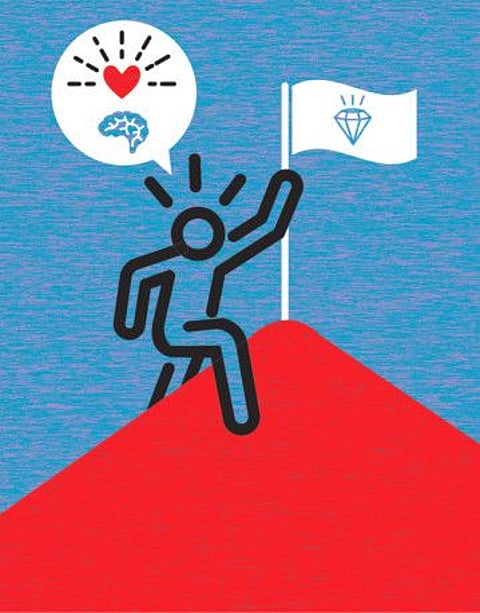Enthusiasm is not about pure emotions alone
Knowing the science behind it can help with any successful pursuit

Also In This Package
If we want to go our own way and not be discouraged by supposed obstacles, we need one thing above all – unshakable inner drive.
Our brains are programmed to use our (physical) resources sparingly and efficiently. This is the origin of the widespread practice of walking the path of least resistance. Even though this may make sense from a biological point of view, we have to get away from this basic attitude if we want to unfold our full potential in life and to courageously go our own way – against all odds.
Grab that enthusiasm
To motivate ourselves to pull something through, we must step out of our comfort zone. If we want to approach the matter with ease, we must consider an emotion with tremendously strong transformational power: Enthusiasm.
With the term ‘enthusiasm’, positive images immediately arise in front of the inner eye of how someone pursues his or her goals with passion while being happy and satisfied at the same time.
Set into motion
Enthusiasm is more than just a positive emotion. It is an accelerator when it comes to building new neuronal connections. When we are excited about a specific task or goal, our midbrain releases a cocktail of neuroplastic messenger substances, including adrenaline and dopamine.
These substances generate new nerve cell contacts and reinforce all those neuronal networks that enable us to achieve exactly what we are enthusiastic about.
Provoking enthusiasm in the short term can be easy; to keep it up long enough and to tackle long-term tasks proves to be difficult and this is the reason why many people find it challenging to decide again for their own way and to enforce it.
In-built
The reason for this is a protective mechanism of our psyche called “hedonic adaptation”, which makes sure that we keep our body in balance allowing as little stress as possible. When our body is stressed, it suspends important basic functions (such as digestion and healing) in favor of functions that would help us to escape a deadly danger.
However, our body makes no distinction between positive and negative stress and therefore tries to quickly reduce strong feelings like enthusiasm to a neutral level.
In 2005, Wendy Boswell, a scientist, accompanied executives for five years for her study. She found that managers were very enthusiastic after a promotion, as expected.
However, she also found that this feeling of ultimate happiness had completely disappeared after a maximum of one year.
A 10% chance?
Scientists estimate that happiness is only determined to 10 per cent by our life circumstances, precisely because we get used to positive new circumstances very quickly due to hedonic adaptation. Another 50 per cent are determined by our genes.
However, on average we influence 40 per cent of our happiness day by day through our thoughts, actions, and behavior.
The question is, how can we manage to use these 40 per cent to create a feeling of enthusiasm empowering ourselves to take the actions that will take us forward on our path?
Emotions are not only a psychological phenomenon that happens in our brain. They are far more than that and can be found in a place where most people do not watch out for them.
Finish scientists carried out a study that was published in 2014 by the National Academy of Science of the US. They obtained solid evidence that our body is involved in all cognitive and emotional functions, that the human mind is truly embodied. Because human beings perceive their emotions in specific places in their body.
For example, most of us perceive fear in the chest area, whereas we mostly feel happiness in our head or our heart. Locating where enthusiasm might have its physical origin in our body, is a mental training to learn to consciously evoke this emotion when we need it.
Evoking enthusiasm can therefore be trained. Just as you can train a muscle by frequently stimulating it, mental training stimulates our brain to strengthen neural connections to certain emotions.
Regularly taking a few minutes to feel enthusiasm in our mind and our body builds a shortcut in our brain and mobilizes our limbic system. Over time, we eventually perceive mental anchors such as symbols, colors, or shapes that empower ourselves to connect to the desired emotion in record speed.
We do not have to be less rational, but in addition, we can get in sync with our emotions. As published by Daniel Goleman back in 1996, highly successful leaders distinguish from average ones mainly by emotional abilities rather than by their cognitive abilities.
If we work towards our goals not only with our mind but also with our heart, we have all the power we need to go our own way and push obstacles aside when we feel that the outcome is worth it.

- Ulrike Seminati is a success coach and author of the book ‘SHINE – Step out of your shadow’.
Sign up for the Daily Briefing
Get the latest news and updates straight to your inbox









